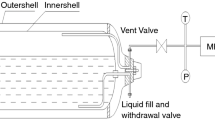Abstract
Purpose
To study the relationship between liquid nitrogen loss and temperature in cryostorage dewars and develop an early-warning alarm for impending tank failure.
Methods
Cryostorage dewars were placed on custom-engineered scales, and weight and temperature data were continuously monitored in the setting of slow, medium, and fast rate-loss of LN2 to simulate three scenarios of tank failure.
Results
LN2 Tank weights and temperatures were continuously monitored and recorded, with a calculated alarm trigger set at 10% weight loss and temperature of − 185 °C. With an intact tank, a 10% loss in LN2 occurred in 4.2–4.9 days. Warming to − 185 °C occurred in 37.8–43.7 days, over 30 days after the weight-based alarm was triggered. Full evaporation of LN2 required ~ 36.8 days. For the medium rate-loss simulation, a 10% loss in LN2 occurred in 0.8 h. Warming to − 185 °C occurred in 3.7–4.8 h, approximately 3 h after the weight-based alarm was triggered. For the fast rate-loss simulation, a 10% weight loss occurred within 15 s, and tanks were depleted in under 3 min. Tank temperatures began to rise immediately and at a relatively constant rate of 43.9 °C/h and 51.6 °C/h. Temperature alarms would have sounded within 0.37 and 0.06 h after the breech.
Conclusions
This study demonstrates that a weight-based alarm system can detect tank failures prior to a temperature-based system. Weight-based monitoring could serve as a redundant safety mechanism for added protection of cryopreserved reproductive tissues.



Similar content being viewed by others
References
Cohen J, Inge KL, Wiker SR, Wright G, Fehilly CB, Turner TGJ. Duration of storage of cryopreserved human embryos. J In Vitro Fert Embryo Transf. 1988;5:301–3.
Glenister PH, Whittingham DG, Lyon MF. Further studies on the effect of radiation during the storage of frozen 8-cell mouse embryos at -196 degrees C. J Reprod Fertil. 1984;70:229–34.
Goldman KN, Kramer Y, Hodes-Wertz B, Noyes N, McCaffrey C, Grifo JA. Long-term cryopreservation of human oocytes does not increase embryonic aneuploidy. Fertil Steril. 2015;103:662–8.
Ueno S, Uchiyama K, Kuroda T, Yabuuchi A, Ezoe K, Okimura T, et al. Cryostorage duration does not affect pregnancy and neonatal outcomes: a retrospective single-centre cohort study of vitrified-warmed blastocysts. Reprod BioMed Online. 2018;36:614–9.
Bulletin A. ASRM statement on second report of storage tank failure. In: ASRM Office of Public Affairs Vol 20, 2018.
Tomlinson M, Morroll D. Risks associated with cryopreservation: a survey of assisted conception units in the UK and Ireland. Hum Fertil (Camb). 2008;11:33–42.
Pomeroy KO. Liquid nitrogen storage tank failure: can we improve the current system? Fertil Steril, www.fertilstertdialog.com, May 19, 2018.
Schiewe MC, Freeman M, Whitney JB, VerMilyea MD, Jones A, Aguirre M et al. Comprehensive assessment of cryogenic storage risk and quality management concerns: best practice guidelines for ART labs. J Assist Reprod Genet 2018; 35(12):in press. https://doi.org/10.1007/s10815-018-1310-6.
Acknowledgements
The authors thank the members of Columbia University Fertility Center for their assistance in conducting the trial.
Funding
ZW is partially supported through funding from the National Institutes of Health (grants HD068546 and U19CA179564). ZW is listed as an inventor on patent applications filed by Columbia University relating to this system.
Author information
Authors and Affiliations
Corresponding author
Additional information
Publisher’s note
Springer Nature remains neutral with regard to jurisdictional claims in published maps and institutional affiliations.
Rights and permissions
About this article
Cite this article
Michaelson, Z.P., Bondalapati, S.T., Amrane, S. et al. Early detection of cryostorage tank failure using a weight-based monitoring system. J Assist Reprod Genet 36, 655–660 (2019). https://doi.org/10.1007/s10815-019-01402-3
Received:
Accepted:
Published:
Issue Date:
DOI: https://doi.org/10.1007/s10815-019-01402-3




